|
Special Features





Image Libraries


|
|
Blog
|
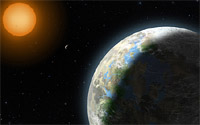
Artist’s impression of the new planet. From NSF. |
For the first time, astronomers have found a planet orbiting another star that is approximately Earth-like in both size and temperature. It’s the first planet outside our home Solar System that astronomers think is a serious candidate to harbor life. One astronomer even goes so far as to say “my own personal feeling is that the chances of life on this planet are 100 percent.”
I grew up watching (and falling in love with) Star Trek, so this sort of thing excites me. My imagination is a flutter with dreams of planner descendants looking out over alien terrain and laying out humanity’s first cities on new worlds.
I sincerely hope we get there some day.
Average Rating: 4.7 out of 5 based on 249 user reviews.
September 30th, 2010 | Permalink
Tags: fun

|

Cahokia: The National Mall of the pre-Columbian United States |
As an older, walkable city with a baroque street grid and no skyscrapers, Washington is sometimes thought of as one of the more European-like cities in America. That may be true, but I think our city can lay claim to an even more interesting title: The most distinctly Native American city in the country.
Obviously Washington is not Santa Fe. There is not a strong Native American cultural influence here. Physically however, Washington bears a strong resemblance to most of the large native cities that populated this continent before the arrival of Columbus.
The key similarity is the National Mall. Archaeologists have discovered that every large native city of any importance had an over-sized ceremonial center populated by palaces, government offices, historic monuments, ball courts, and religious pyramids. The National Mall may not have the religious importance that native centers had, but the basic idea was the same. They are all the ceremonial heart of the city and state.
Cahokia, the largest native city ever built in what is now the United States, had a ceremonial center. Tenochtitlan, the largest Aztec city, had one. Tikal, the most important city-state of the classical Maya, had one.
So did Teotihuacan, Chichen Itza, Winterville, virtually every large native city in North America. The list is dozens of cities long.
Meanwhile, no contemporary American city besides Washington has a ceremonial center the likes of the National Mall. San Francisco and Denver have monumental civic centers, while Cleveland, Detroit, Indianapolis, and a host of other cities have central plazas, but only Washington has a monumental core as large and central to the city as the Mall. Only the Mall is comparable in scale to the centers of the large native cities.
While cultural influences may ultimately trump urban layout, it’s certainly interesting that Pierre L’Enfant would unknowingly design a new capital city with such traditionally American features.
Luckily, there was no architectural establishment around to call it faux historic kitsch.
Average Rating: 4.6 out of 5 based on 195 user reviews.
September 29th, 2010 | Permalink
Tags: architecture, history, urbandesign

While looking up information on the Arlington County website for last week’s post about Rosslyn Metro, I discovered these historic aerial images of Rosslyn.
The first, from 1953, shows Rosslyn as a historic neighborhood. The second and third show it in the midst of high rise redevelopment.
Fascinating stuff.

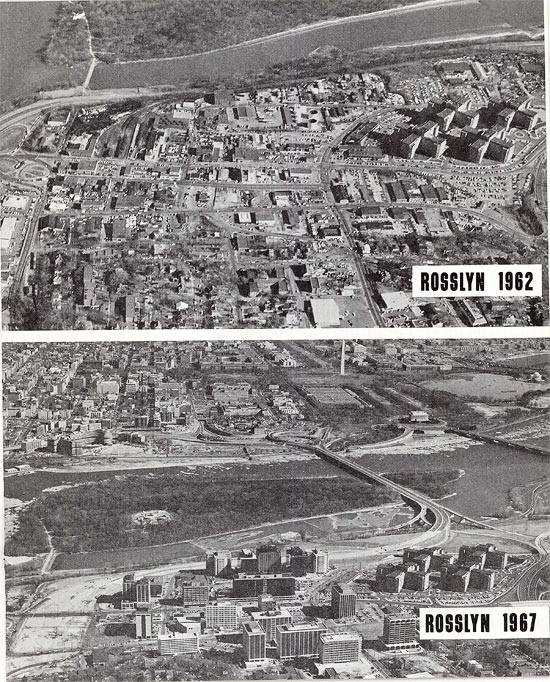
Images from Arlington County. Originals here and here.
Average Rating: 4.4 out of 5 based on 195 user reviews.
September 28th, 2010 | Permalink
Tags: galleries, history

Metro Center has four main entrances. Gallery Place and L’Enfant Plaza each have three. Union Station, Silver Spring, Dupont Circle, and countless others have two. Rosslyn, the highest-ridership station in Virginia, has but one. One entrance with one set of long, slow escalators and one often-broken elevator, to serve all 36, 000 daily passengers who enter and exit there (more than Baltimore’s entire light rail line). It is serious capacity bottleneck and safety risk, and has to be fixed if Rosslyn is to accommodate its slew of planned new skyscrapers.
So Arlington is building a second entrance across North Moore Street from the existing entrance, in what will become a new plaza.
The entrance will include three new high-speed elevators (like those at Forest Glen), an expanded mezzanine area, a new station manager kiosk with additional fare gates and pay stations, and an emergency stairwell. It will also include additional parking for cars and bicycles as part of the private development above.
The rendering below illustrates how it will all work. The image shows the street at top and existing Metro tunnel at bottom. The existing escalator and mezzanine are shown in dark gray near the center. The new elevators, stairs and mezzanine are in lighter gray to the right.
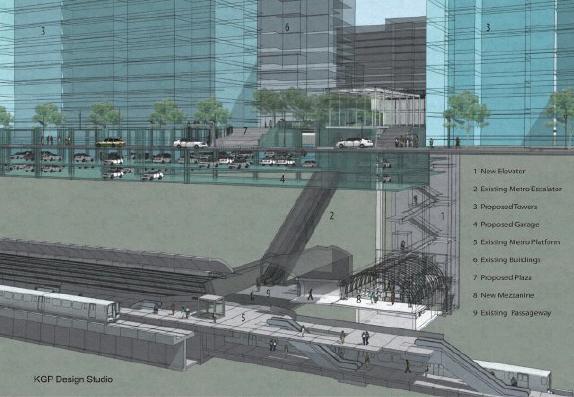
Rosslyn’s new entrance. Image from Arlington County.
When complete, this new entrance – and the new development it is attached to – will make for a dramatically improved Rosslyn neighborhood and station. It’s a good project, and it’s been a long time coming.
For more renderings, check out Arlington’s web page.
Average Rating: 4.7 out of 5 based on 255 user reviews.
September 24th, 2010 | Permalink
Tags: development, metrorail, transportation

I haven’t used Capital Bikeshare yet because the stations convenient to my commute have yet to be installed. However, on my walk home yesterday I got my first look at a fully-stocked-and-ready-to-use station, and couldn’t help but stop and snap a couple of pictures.
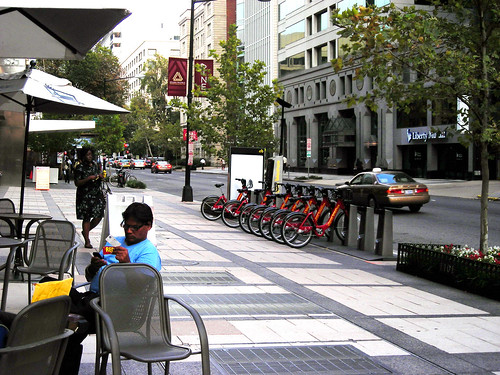
Isn’t this beautiful?
A few more pictures at the bottom of my cycling folder.
Average Rating: 4.8 out of 5 based on 188 user reviews.
September 23rd, 2010 | Permalink
Tags: bike, galleries, transportation

|
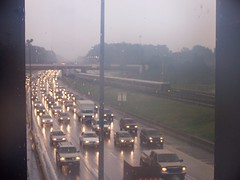
No thanks |
Today is Car-Free Day. For me, so was yesterday and the day before. I have now been car-free for more than 10 years, ever since January, 2000.
It all started when I went to college. I had a car in high school, a beat-up Civic, but didn’t take it with me to school in Colorado (go Buffs!). I spent most of my four years in Boulder living in the University Hill neighborhood, a student ghetto that is one of the most functionally urban places in the Mountain Time Zone. I walked to most destinations, and rode Boulder’s fabulous bus system to the rest. I didn’t bike much, but a lot of other people did.
When I returned east during breaks, I couldn’t help but notice how much better Washington’s urbanity was than that of Boulder or Denver. I knew that what I was doing in Boulder could be done here even more easily. I graduated, found a job in Fairfax, and moved to Ballston – the closest suitably urban place to my job. Later I moved to a new work place in Arlington and a new home in Northwest DC, making the car-free life even easier.
From time to time over the past 10 years I’ve considered buying a car. I’m not a zealot, just practical, and I haven’t taken the car-ownership plunge because I continue to find owning a car to be more hindrance than help. Most of my trips are simply easier to make on foot, bike or transit. When the need arises, I rent cars through ZipCar or Enterprise, but except for making out-of-town trips the need rarely arises. When it does, it doesn’t take much sitting in traffic or circling for parking to remind me why I like being car-free.
Ultimately, the car-free lifestyle has been more convenient for me, on top of more healthy, more affordable, and more green. I’m glad I gave city living a try 10 years ago, and can’t imagine going back.
To the thousands of people giving car-free life a try, today’s events are a reminder that life doesn’t have to revolve around cars. You don’t have to spend hours a day stuck in traffic, or looking for parking. There is an opt-out. You can take it. People do, and life goes on.
Average Rating: 4.6 out of 5 based on 224 user reviews.
September 22nd, 2010 | Permalink
Tags: history, transportation

Last week I suggested in the Post Local Blogging Network that Phase Two of the Silver Line may not be the best investment, because we could accomplish more for the same cost using streetcars and BRT. I stand by that statement, but practically speaking it comes too late. The decision has been made and the funding streams are in place.
But while it may be too late for the Silver Line, some day our region will face the same question again: Invest in a single extension of Metro, or build a whole network of less expensive light rail. I hope when that time comes, we will learn from the past and invest in a larger regional network.
In a post today at Greater Greater Washington, I retool my original Washington Post column to accept the Silver Line, but express hope for a different decision next time.
Average Rating: 5 out of 5 based on 255 user reviews.
September 21st, 2010 | Permalink
Tags: metrorail, transportation

This is a map of the Washington region by population ethnicity as of the 2000 census. Each dot represents 25 people. Red dots are Caucasians, blue dots are Blacks, yellow/orange dots are Hispanics, and green dots are Asians. The map is part of a series created by flickr user Eric Fischer showing the 40 largest cities.
White it’s important to note that this data is 10 years out of date and undoubtedly seriously obsolete, it is nonetheless interesting. The familiar east-west white-black divide is obvious (although not nearly as stark as the divide in Detroit), but isn’t it interesting to spot the pockets of overall diversity, and to see how clearly Metro stations in Northwest and Montgomery County stand out.
What patterns do you see? What do you think will be different about this map when census 2010 data comes out?

Average Rating: 4.6 out of 5 based on 202 user reviews.
September 20th, 2010 | Permalink
Tags: in general, social

My Capital Bikeshare membership packet arrived in the mail yesterday, in time for Monday’s system launch. This picture shows the key I’ll use to unlock bikes from stations.
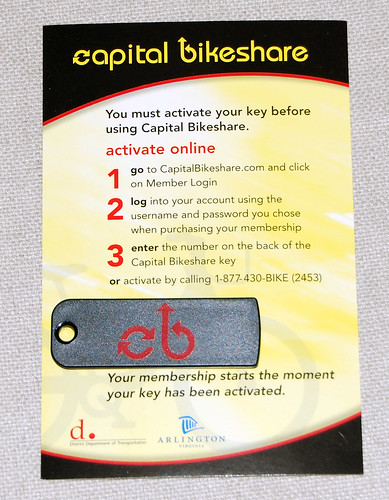
Average Rating: 4.6 out of 5 based on 242 user reviews.
September 17th, 2010 | Permalink
Tags: bike, transportation

Phase One of the Silver Line is one of the most promising infrastructure investments in America, by virtue of the effects it will have on Tysons Corner. Phase Two, on the other hand, costs more and won’t accomplish as much.
In today’s installment of the Washington Post Local Blogging Network, I argue that Northern Virginia would benefit more by spending the money it has allocated for Phase Two on a network of BRT and light rail / streetcar lines. Instead of one Metro line with a handful of stations in the outer suburbs, every major corridor in Northern Virginia could be blanketed with high-quality transit.
Average Rating: 4.6 out of 5 based on 187 user reviews.
September 16th, 2010 | Permalink
Tags: BRT, lightrail, metrorail, streetcar, transportation, washpostblog

|
Media





Site
About BeyondDC
Archive 2003-06
Contact
Category Tags:
Partners
|






















